Quantitative Analysis and Prediction of Academic Performance of Students Using Machine Learning
Abstract
:1. Introduction
2. Academic Performance Evaluation and Machine Learning
2.1. Academic Performance Evaluation
2.2. Machine Learning
2.2.1. Support Vector Machine (SVM)
2.2.2. Artificial Neural Networks
2.2.3. Decision Tree
2.2.4. Ensemble Learning
3. Theoretical Framework: Machine Learning-Based Prediction of Academic Performance
3.1. Main Idea
3.2. The Academic Performance Presentation Based on Machine Learning
3.3. Data Generation
3.4. Prediction of the Academic Performance
3.5. Procedure of Machine Learning-Based Educational Data Mining
4. Evaluation and Discussion
4.1. Dataset
4.2. Evaluation the Academic Performance Using Machine Learning
4.3. Results
4.3.1. Prediction
4.3.2. Performance Comparison
4.3.3. Sensitive Analysis
4.3.4. Feature Importance Based on Machine Learning
4.3.5. Feature Analysis of Machine Learning Model for the Academic Performance
4.4. Discussion
4.4.1. Complexity of the Academic Performance
4.4.2. Significance of Machine Learning
4.5. Implication
4.6. Limitation
5. Conclusions
- (1)
- It is challenging to present the complex relationship between academic performance and its influencing factors. This study investigated machine learning-based academic performance based on the collected data. Machine learning provides an excellent and reliable tool to quantify and predict students’ academic performance;
- (2)
- Various factors influence academic performance, and the feature importance depends on the evaluation model. In order to enhance the prediction accuracy and scientifically characterize educational behavior, as many influencing factors as possible should be considered in the machine learning-based evaluation model;
- (3)
- Machine learning is a data-driven machine learning with excellent interpretable performance. Machine learning-based academic performance could be used to explain educational behavior, conduct an in-depth analysis of each influencing factor of students and explore the education evaluation law. Furthermore, machine learning is helpful for other complex problems of education evaluation;
- (4)
- Machine learning is an excellent tool for evaluating students’ academic performance and understanding educational law and learning behavior. A machine learning-based academic performance model is helpful to guide the education process and update the learning strategy;
- (5)
- This study illustrated the quantitative model of academic performance based on machine learning and the collected dataset. Due to the complexity of education behavior, this study only investigated some machine learning technology. With the accumulation and increasing data, the developed model will further extend and deepen in future studies. Meanwhile, various new technology will apply to evaluate students’ academic performance with machine learning development.
Author Contributions
Funding
Institutional Review Board Statement
Informed Consent Statement
Data Availability Statement
Conflicts of Interest
References
- Bai, L.; Yang, B.; Yuan, S. Evaluating of Education Effects of Online Learning for Local University Students in China: A Case Study. Sustainability 2023, 15, 9860. [Google Scholar] [CrossRef]
- Doukanari, E.; Ktoridou, D.; Efthymiou, L.; Epaminonda, E. The Quest for Sustainable Teaching Praxis: Opportunities and Challenges of Multidisciplinary and Multicultural Teamwork. Sustainability 2021, 13, 7210. [Google Scholar] [CrossRef]
- Doyumğaç, İ.; Tanhan, A.; Kıymaz, M.S. Understanding the most important facilitators and barriers for online education during COVID-19 through online photovoice methodology. Int. J. High. Educ. 2021, 10, 166–190. [Google Scholar] [CrossRef]
- Subasi, Y.; Adalar, H.; Tanhan, A.; Arslan, G.; Allen, K.; Boyle, C.; Lissack, K.; Collett, K.; Lauchlan, F. Investigating students’ experience of online/distance education with photovoice during COVID-19. Distance Educ. 2023. [Google Scholar] [CrossRef]
- Sánchez, A.; Vidal-Silva, C.; Mancilla, G.; Tupac-Yupanqui, M.; Rubio, J.M. Sustainable e-Learning by Data Mining—Successful Results in a Chilean University. Sustainability 2023, 15, 895. [Google Scholar] [CrossRef]
- Chen, X.; Vorvoreanu, M.; Madhavan, K. Mining social media data for understanding students’ learning experiences. IEEE Trans. Learn. Technol. 2014, 72, 46–259. [Google Scholar] [CrossRef]
- Mustafa, Y. Educational data mining: Prediction of students’ academic performance using machine learning algorithms. Smart Learn. Environ. 2022, 9, 11. [Google Scholar] [CrossRef]
- Aina, C.; Baici, E.; Casalone, G.; Pastore, F. The determinants of university dropout: A review of the socio-economic literature. Socio-Econ. Plan. Sci. 2021, 79, 101102. [Google Scholar] [CrossRef]
- Khan, A.; Ghosh, S.K. Student performance analysis and prediction in classroom learning: A review of educational data mining studies. Educ. Inf. Technol. 2021, 26, 205–240. [Google Scholar] [CrossRef]
- Namoun, A.; Alshanqiti, A. Predicting student performance using data mining and learning analytics techniques: A systematic literature review. Appl. Sci. 2021, 11, 237. [Google Scholar] [CrossRef]
- Upadhyay, H.; Juneja, S.; Juneja, A.; Dhiman, G.; Kautish, S. Evaluation of ergonomics-related disorders in online education using fuzzy AHP. Comput. Intell. Neurosci. 2021, 2021, 2214971. [Google Scholar] [CrossRef]
- Asad, R.; Altaf, S.; Ahmad, S.; Mahmoud, H.; Huda, S.; Iqbal, S. Machine Learning-Based Hybrid Ensemble Model Achieving Precision Education for Online Education Amid the Lockdown Period of COVID-19 Pandemic in Pakistan. Sustainability 2023, 15, 5431. [Google Scholar] [CrossRef]
- Mohamada, S.K.; Tasir, Z. Educational data mining: A review. Procedia-Soc. Behav. Sci. 2013, 97, 320–324. [Google Scholar] [CrossRef]
- Baker, R.S.J.D.; Yacef, K. The state of educational data mining in. A review and future visions. J. Educ. Data Min. 2009, 1, 3–17. [Google Scholar] [CrossRef]
- Papadogiannis, I.; Poulopoulos, V.; Wallace, M. A Critical Review of Data Mining for Education: What has been done, what has been learnt and what remains to be seen. Int. J. Educ. Res. Rev. 2020, 5, 353–372. [Google Scholar] [CrossRef]
- Thai-Nghe, N.; Drumond, L.; Krohn-Grimberghe, A.; Schmidt-Thieme, L. Recommender system for predicting student performance. Procedia Comput. Sci. 2010, 1, 2811–2819. [Google Scholar] [CrossRef]
- Elbadrawy, A.; Studham, S.; Karypis, G. Personalized Multi-regression models for predicting students’ performance in course activities. In Proceedings of the 5th International Conference on Learning Analytics and Knowledge, Poughkeepsie, NY, USA, 16–20 March 2015; pp. 16–20. [Google Scholar] [CrossRef]
- Polyzou, A.; Karypis, G. Grade prediction with models specific to students and courses. Int. J. Data Sci. Anal. 2016, 2, 159–171. [Google Scholar] [CrossRef]
- Bao, C.; Li, Y.; Zhao, X. The Influence of Social Capital and Intergenerational Mobility on University Students’ Sustainable Development in China. Sustainability 2023, 15, 6118. [Google Scholar] [CrossRef]
- Deng, J.; Gu, D.; Li, X.; Yue, Z.Q. Structural reliability analysis for implicit performance functions using artificial neural network. Struct. Safe 2005, 27, 25–48. [Google Scholar] [CrossRef]
- Wang, L.; Wang, C.; Khoshnevisan, S.; Ge, Y.; Sun, Z. Determination of two-dimensional joint roughness coefficient using support vector regression and factor analysis. Eng. Geol. 2017, 231, 238–251. [Google Scholar] [CrossRef]
- Zhao, H.; Yin, S.; Ru, Z. Relevance vector machine applied to slope stability analysis. Int. J. Numer. Anal. Method Geomech. 2012, 36, 643–652. [Google Scholar] [CrossRef]
- Ren, J.; Zhao, H.; Zhang, L.; Zhao, Z.; Xu, Y.; Cheng, Y.; Wang, M.; Chen, J.; Wang, J. Design optimization of cement grouting material based on adaptive Boosting algorithm and simplicial homology global optimization. J. Build. Eng. 2022, 49, 104049. [Google Scholar] [CrossRef]
- He, M.; Zhang, L. Machine learning and symbolic regression investigation on stability of MXene materials. Comput. Mater. Sci. 2021, 196, 110578. [Google Scholar] [CrossRef]
- Kabra, R.R.; Bichkar, R.S. Performance prediction of engineering students using decision trees. Int. J. Comput. Appl. 2011, 36, 8–12. [Google Scholar] [CrossRef]
- Bhardwaj, B.K.; Pal, S. Data Mining: A prediction for performance improvement using classifcation. Int. J. Comput. Sci. Inf. Secur. 2011, 9, 355–358. [Google Scholar] [CrossRef]
- Arsad, P.M.; Buniyamin, N.; Manan, J.-L. Neural network model to predict electrical students’ academic performance. In Proceedings of the 4th International Congress on Engineering Education (ICEED), Georgetown, Malaysia, 5–7 December 2012. [Google Scholar] [CrossRef]
- Hamsa, H.; Indiradevi, S.; Kizhakkethottam, J.J. Student academic performance prediction model using decision tree and fuzzy genetic algorithm. Procedia Technol. 2016, 25, 326–332. [Google Scholar] [CrossRef]
- MohammadNoor, I.; Abdallah, M.; Ali, B.N.; Abdallah, S. Multi-split optimized bagging ensemble model selection for multi-class educational data mining. Appl. Intell. 2020, 504, 506–4528. [Google Scholar] [CrossRef]
- Zhang, W.; Wang, Y.; Wang, S. Predicting academic performance using tree-based machine learning models: A case study of bachelor students in an engineering department in China. Educ. Inf. Technol. 2022, 271, 3051–13066. [Google Scholar] [CrossRef]
- Juan, A.T.C.; Héctor, G.C. A stacking ensemble machine learning method for early identifcation of students at risk of dropout. Educ. Inf. Technol. 2023, 1–21. [Google Scholar] [CrossRef]
- Cédric, B.; Jefrey, S.R. Predicting University Students’ Academic Success and Major Using Random Forests. Res. High. Educ. 2019, 60, 1048–1064. [Google Scholar] [CrossRef]
- Vidhya, R.; Vadivu, G. Towards developing an ensemble based two-level student classifcation model (ESCM) using advanced learning patterns and analytics. J. Ambient. Intell. Humaniz. Comput. 2021, 127, 095–7105. [Google Scholar] [CrossRef]
- Sinem, B.K.; Sevda, A. HELA: A novel hybrid ensemble learning algorithm for predicting academic performance of students. Educ. Inf. Technol. 2022, 27, 4521–4552. [Google Scholar] [CrossRef]
- Bansal, V.; Buckchash, H.; Raman, B. Computational intelligence enabled student performance estimation in the age of COVID-19. SN Comput. Sci. 2022, 3, 41. [Google Scholar] [CrossRef]
- Singh, S.; Malik, S.; Singh, P. Factors Affecting the Academic Performance of Students. J. Educ. Pract. 2016, 114509778. [Google Scholar] [CrossRef]
- Bakhshinategh, B.; Zaiane, O.R.; ElAtia, S.; Ipperciel, D. Educational data mining applications and tasks: A survey of the last 10 years. Educ. Inf. Technol. 2017, 23, 537–553. [Google Scholar] [CrossRef]
- Vapnik, V.N.; Golowich, S.E.; Smola, A.J. Support vector method for function approximation, regression estimation, and signal processing. Adv. Neural Inf. Process. Syst. 1996, 9, 281–287. [Google Scholar]
- Suykens JA, K.; Vandewalle, J. Least squares support vector machine classifiers. Neural Process. Lett. 1999, 9, 293–300. [Google Scholar] [CrossRef]
- Smola Alex, J.; Schölkopf, B. A tutorial on support vector regression. Stat. Comput. 2004, 14, 199–222. [Google Scholar] [CrossRef]
- Hopfield, J.J. Neurons with graded response have collective computational properties like those of two-state neurons. Proc. Natl. Acad. Sci. USA 1984, 81, 3088–3092. [Google Scholar] [CrossRef]
- Rumelhart, D.E.; Hinton, G.; Williams, R.J. Learning representations by back-propagating errors. Nature 1986, 323, 533–536. [Google Scholar] [CrossRef]
- Rokach, L.; Maimon, O. Data Mining with Decision Trees: Theory and Applications, 2nd ed.; World Scientific Pub Co., Inc.: Singapore, 2014; p. 200814. [Google Scholar] [CrossRef]
- Quinlan, J.R. Induction of decision trees. Mach. Learn. 1986, 1, 81–106. [Google Scholar] [CrossRef]
- Kamiński, B.; Jakubczyk, M.; Szufel, P. A framework for sensitivity analysis of decision trees. Cent. Eur. J. Oper. Res. 2017, 26, 135–159. [Google Scholar] [CrossRef] [PubMed]
- Cortez, P. Student Performance. UCI Machine Learning Repository. 2014. Available online: https://archive.ics.uci.edu/dataset/320/student+performance (accessed on 16 June 2023).


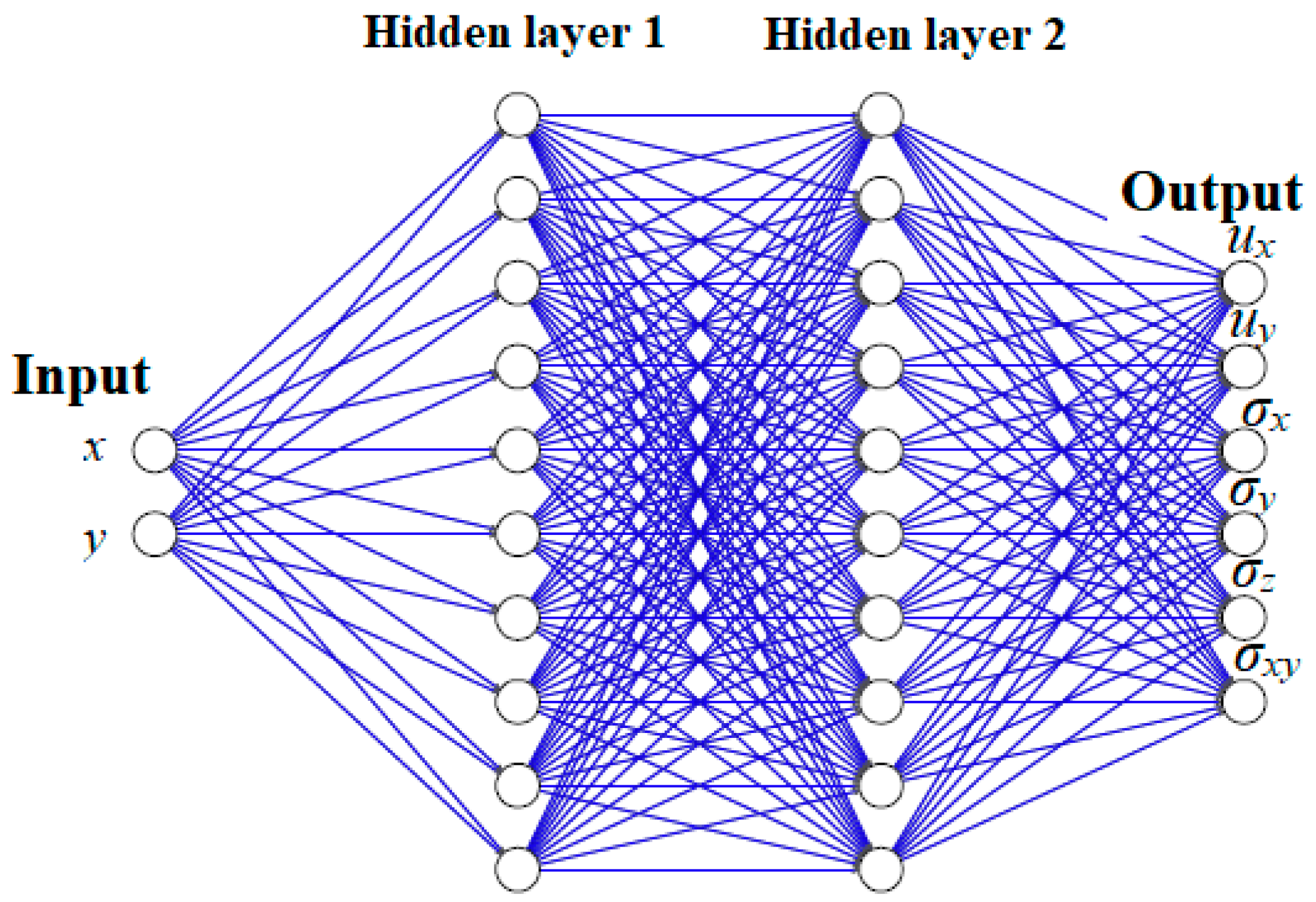
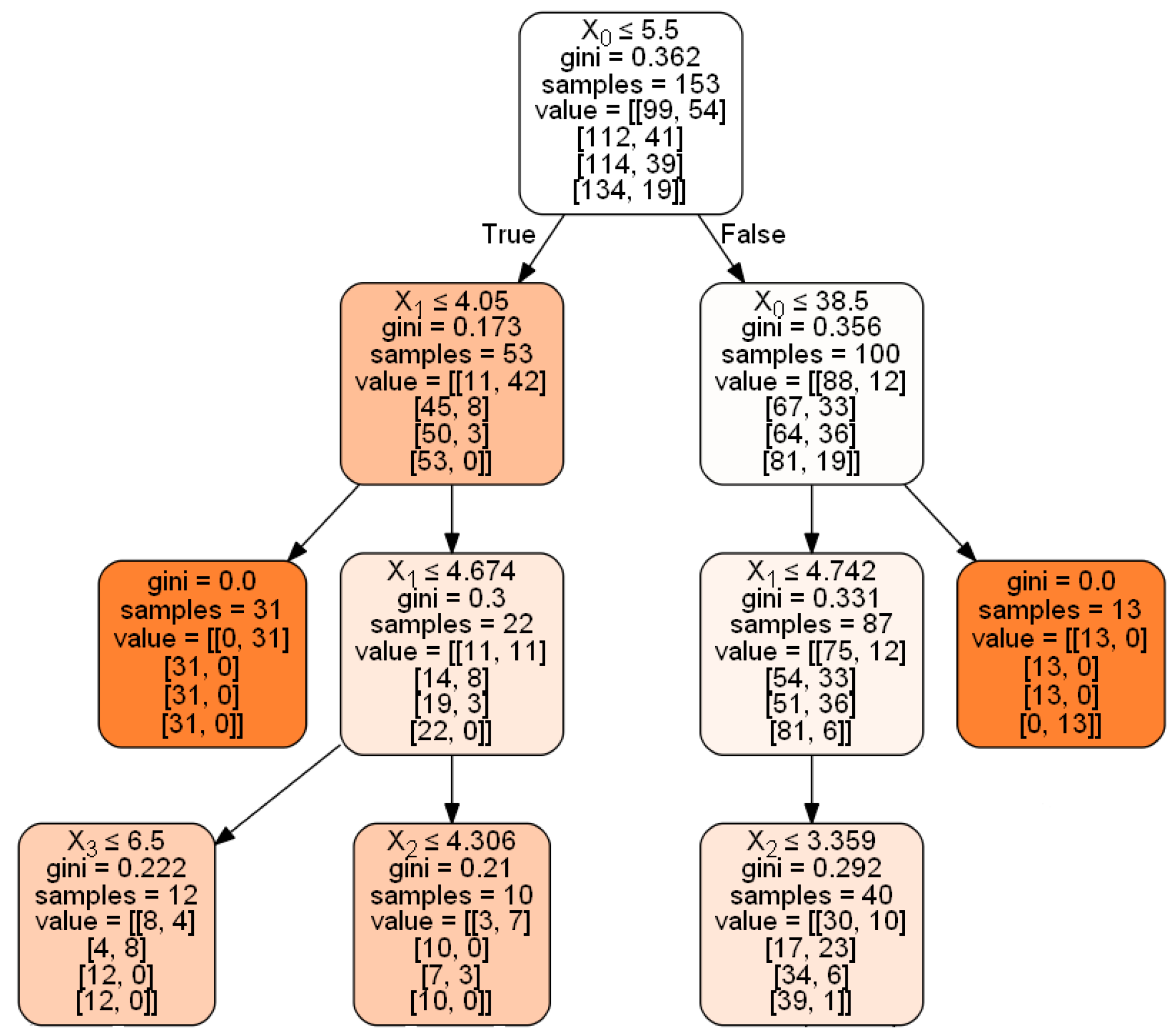

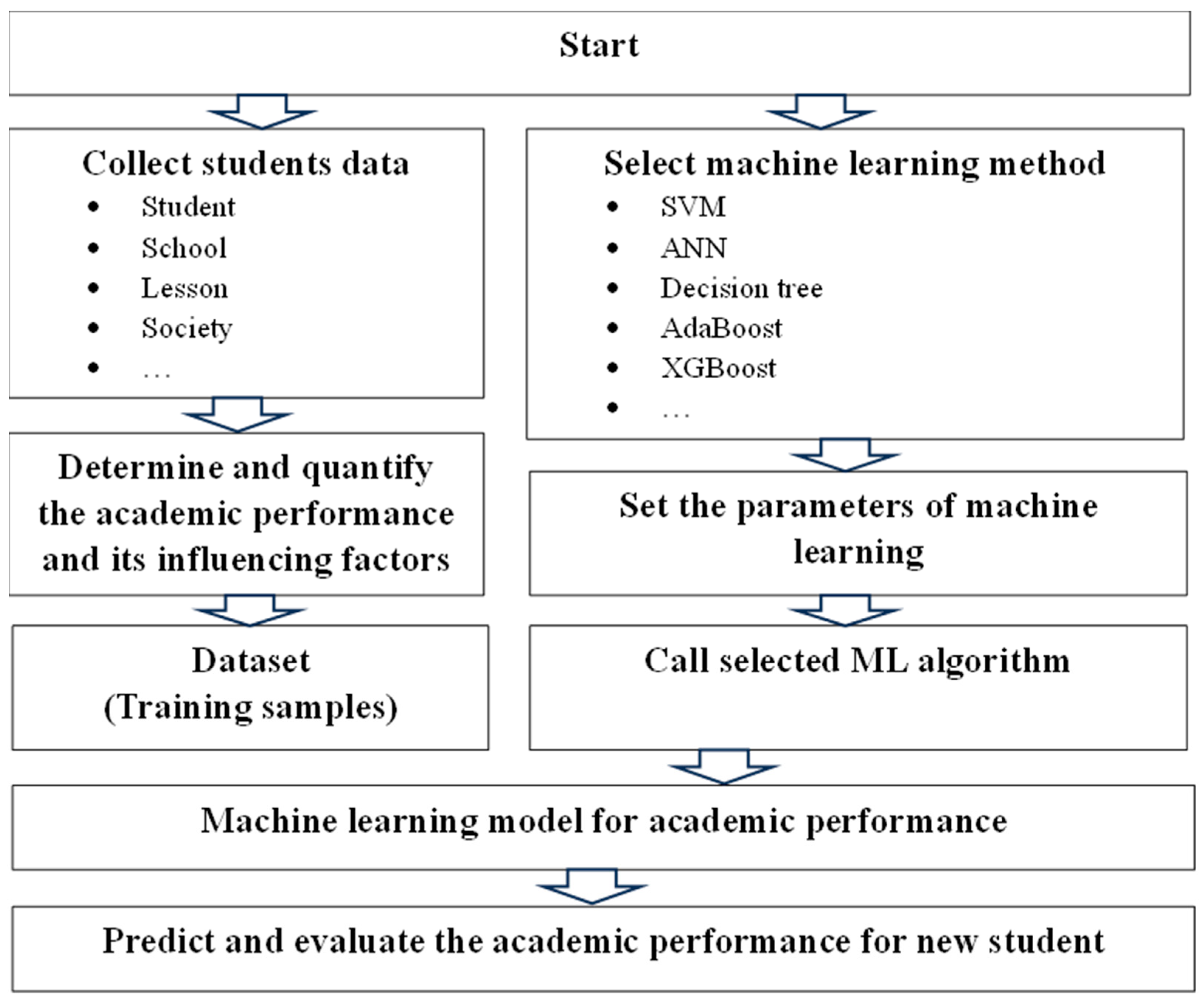

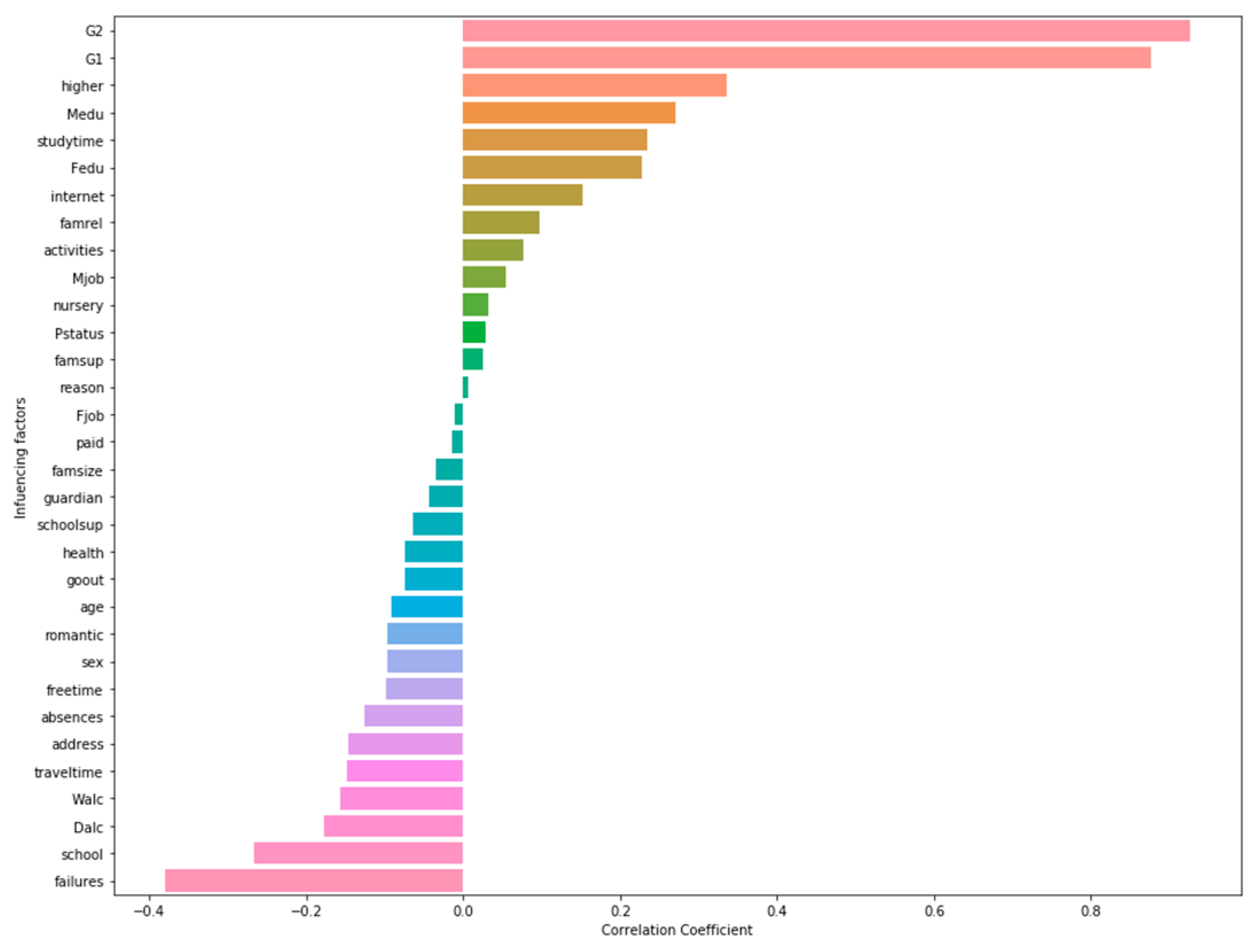
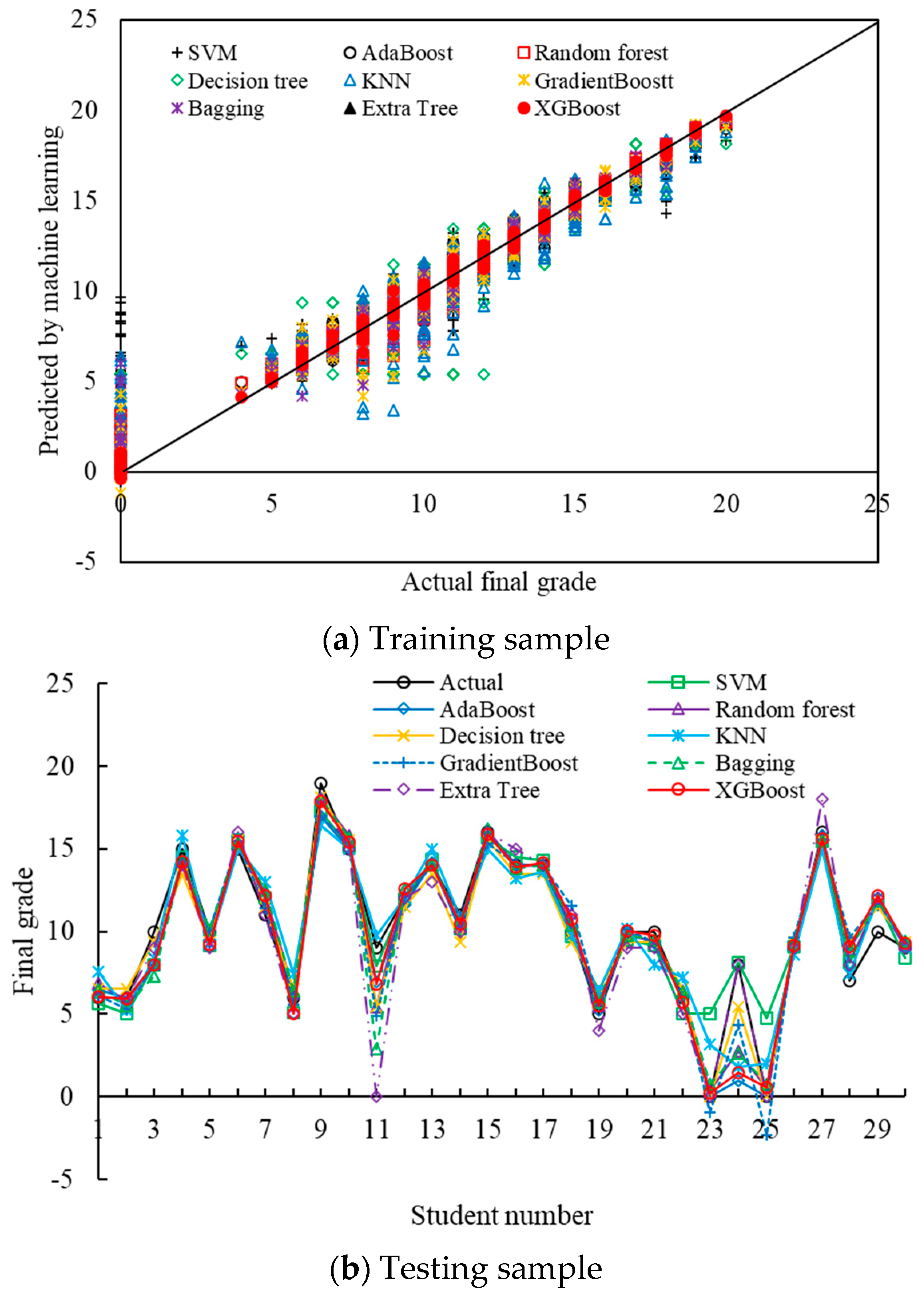

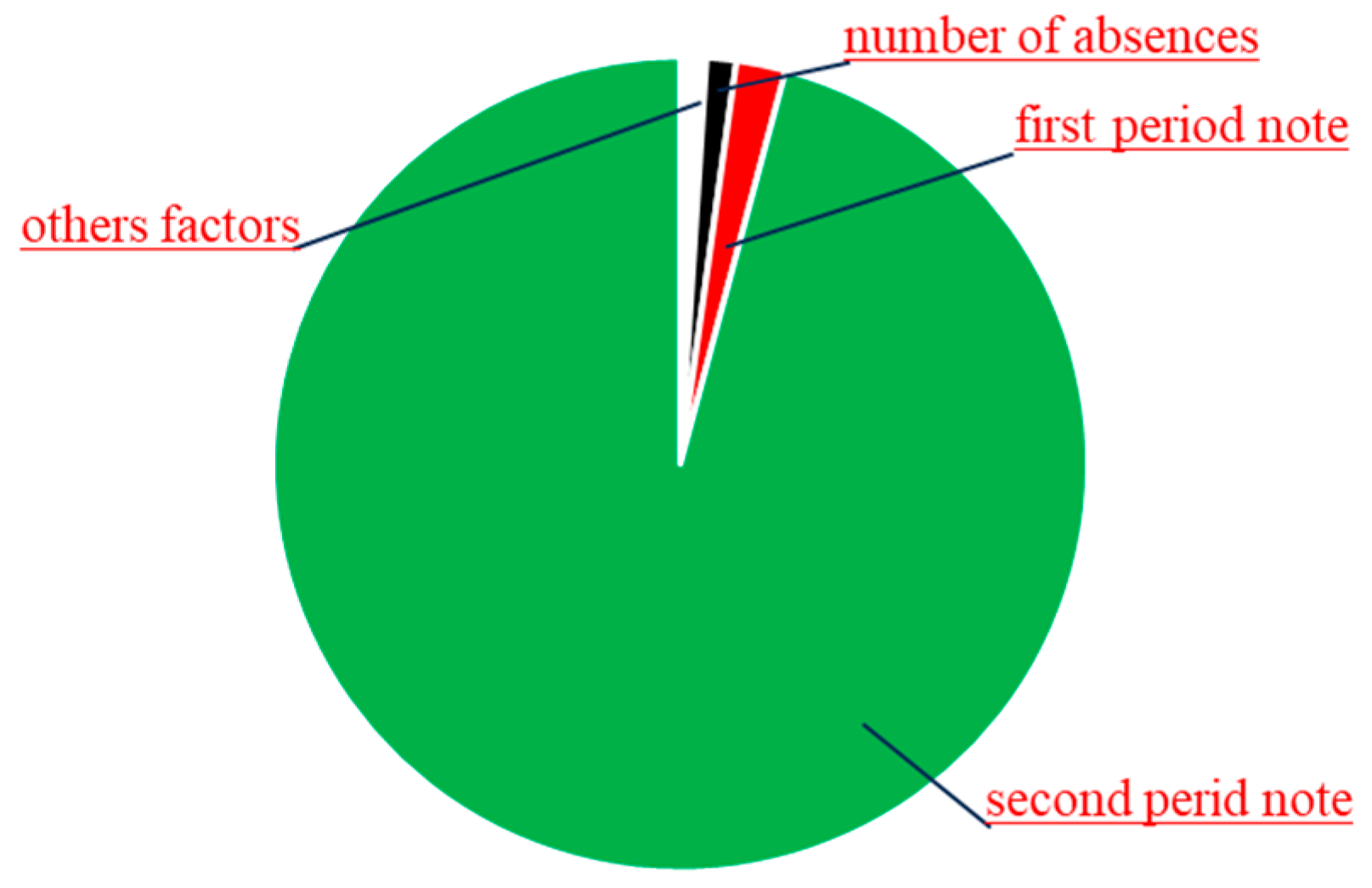
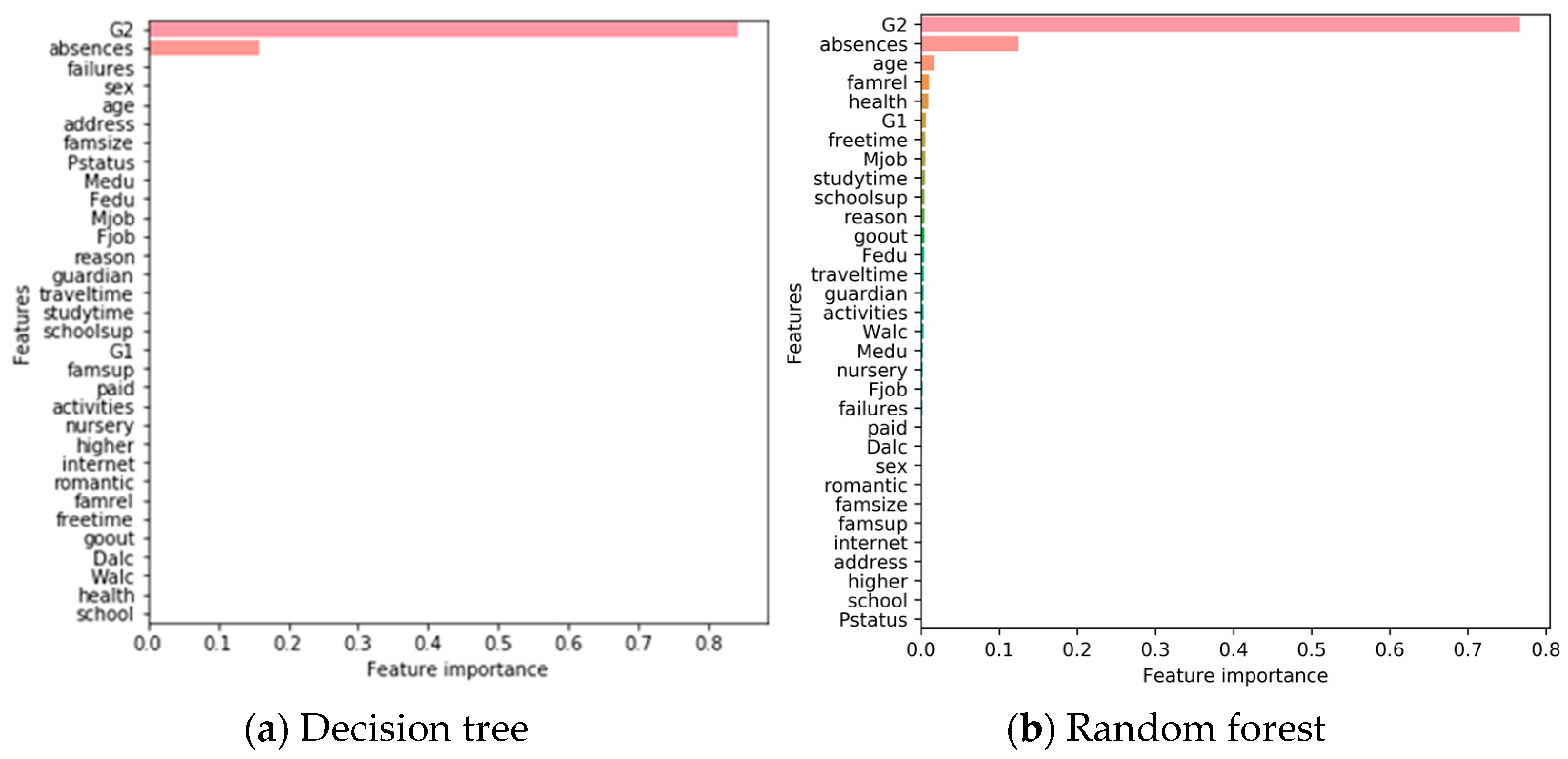
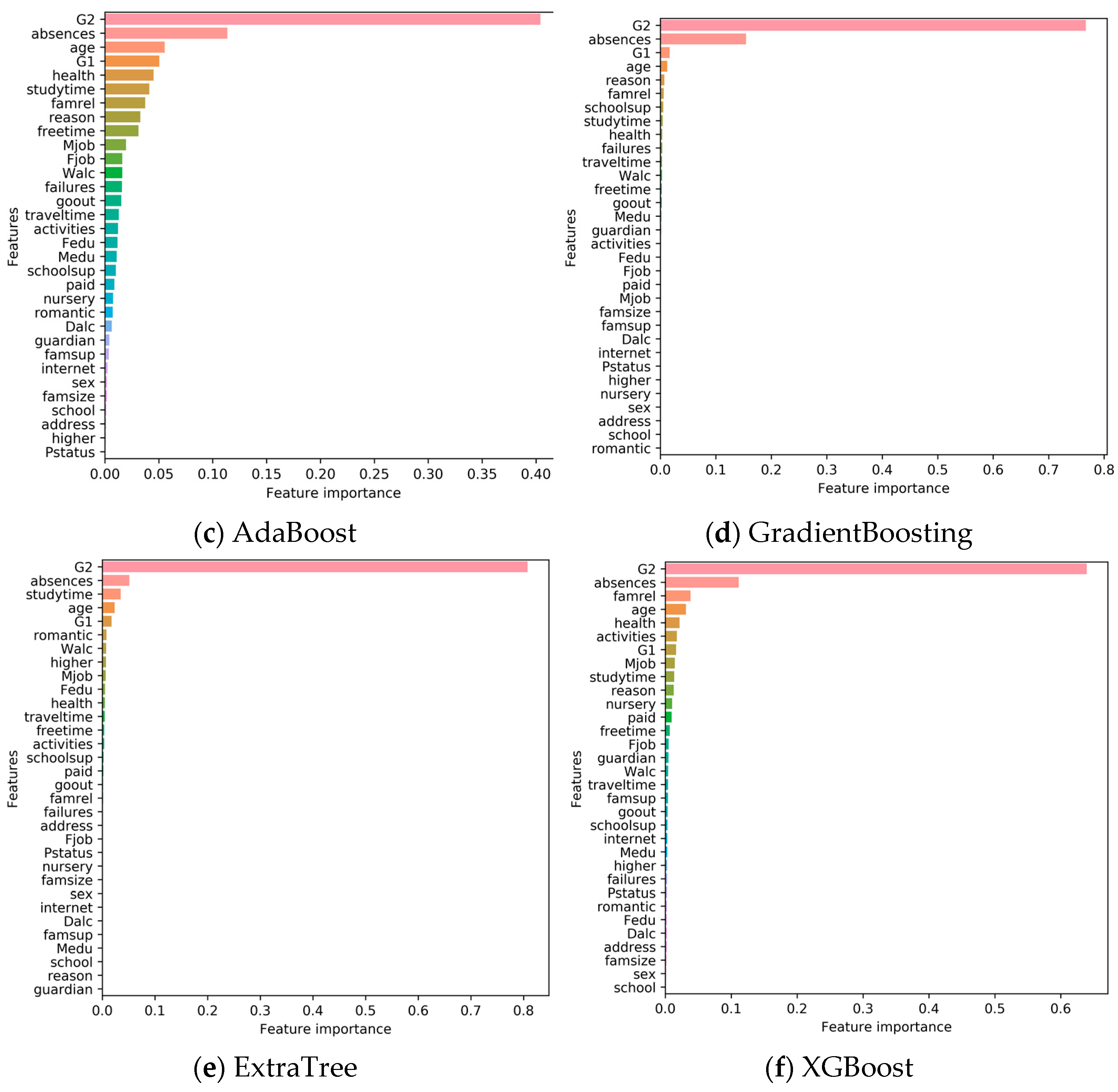
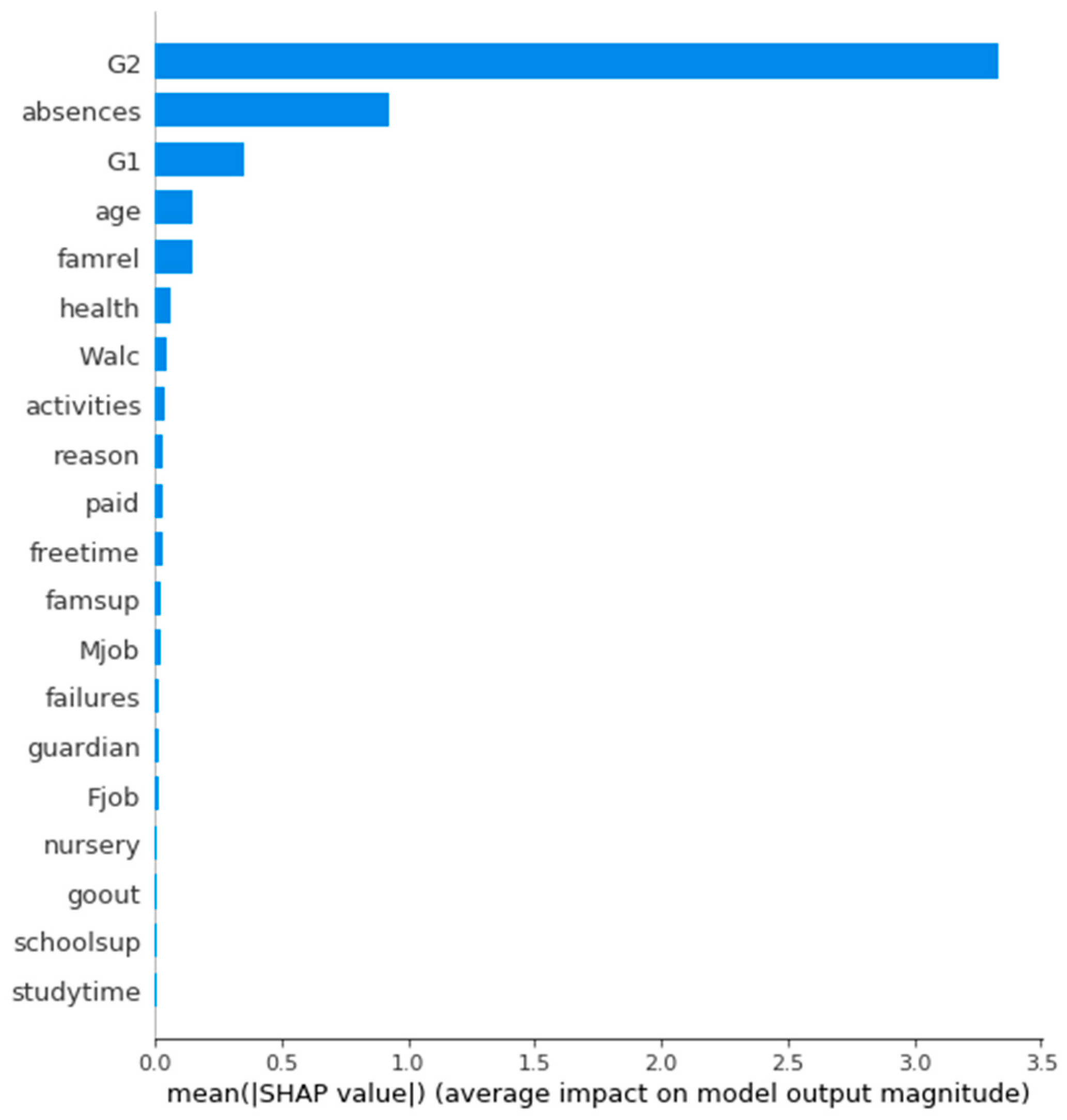
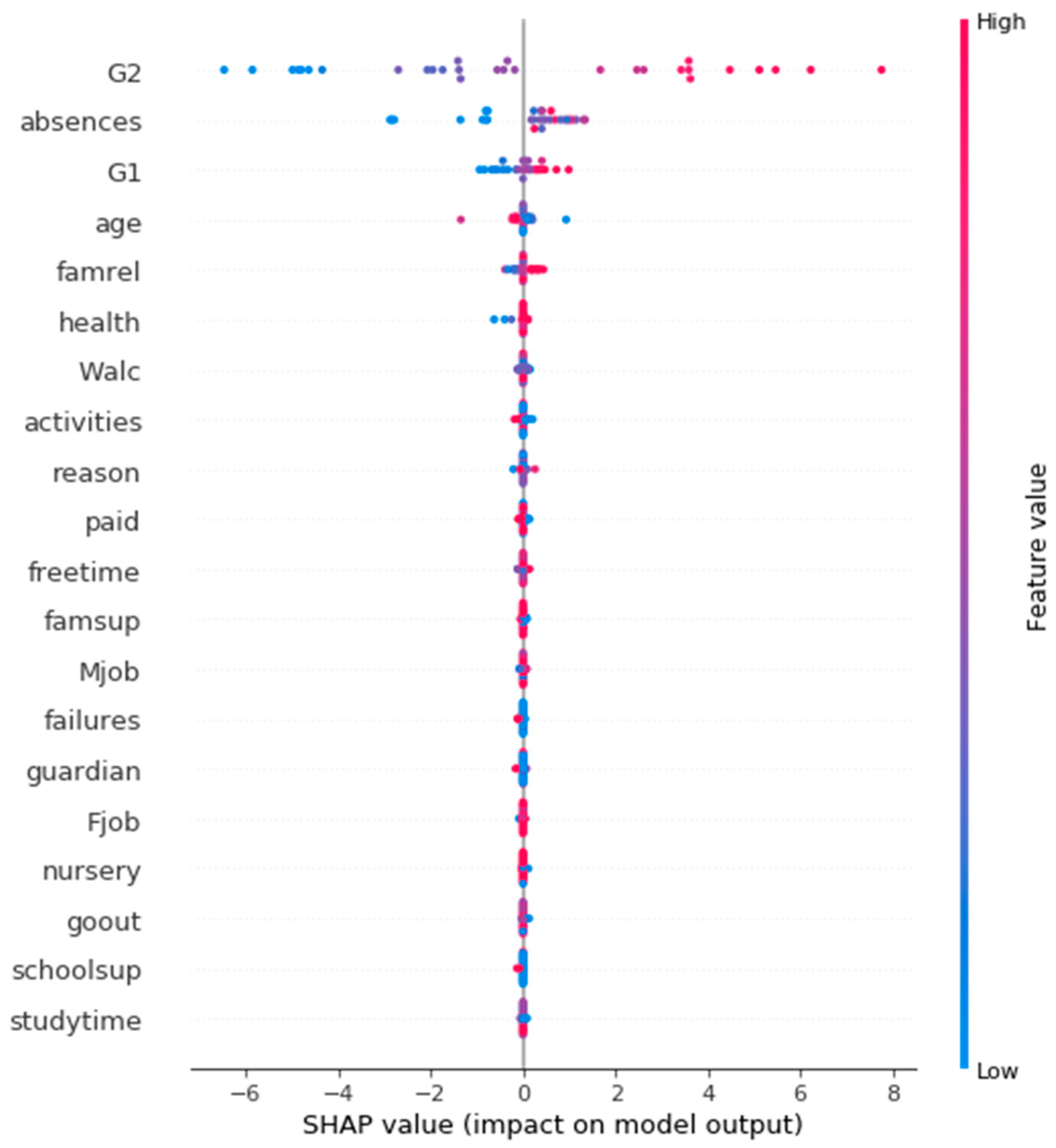
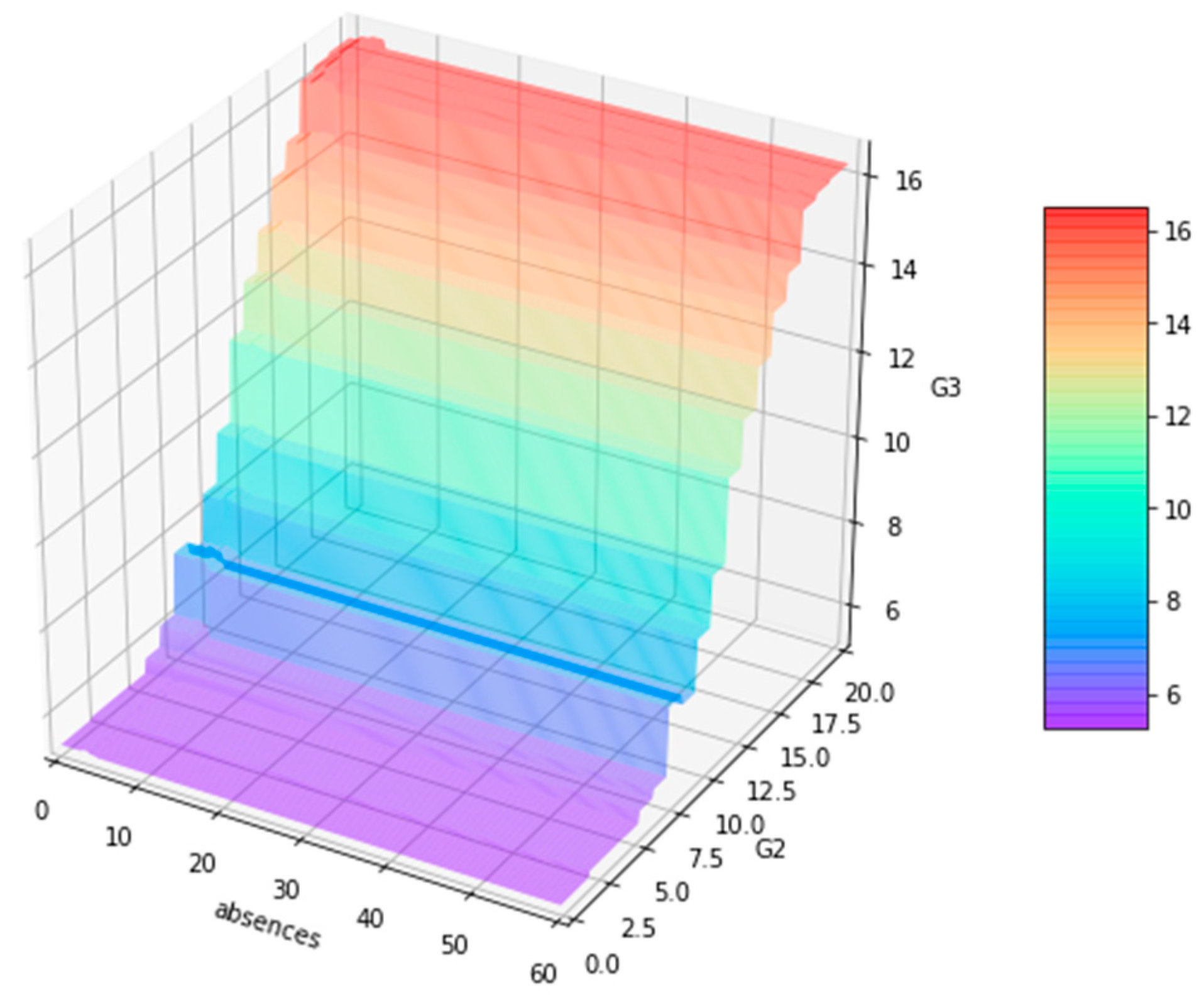
Disclaimer/Publisher’s Note: The statements, opinions and data contained in all publications are solely those of the individual author(s) and contributor(s) and not of MDPI and/or the editor(s). MDPI and/or the editor(s) disclaim responsibility for any injury to people or property resulting from any ideas, methods, instructions or products referred to in the content. |
© 2023 by the authors. Licensee MDPI, Basel, Switzerland. This article is an open access article distributed under the terms and conditions of the Creative Commons Attribution (CC BY) license (https://creativecommons.org/licenses/by/4.0/).
Share and Cite
Zhao, L.; Ren, J.; Zhang, L.; Zhao, H. Quantitative Analysis and Prediction of Academic Performance of Students Using Machine Learning. Sustainability 2023, 15, 12531. https://doi.org/10.3390/su151612531
Zhao L, Ren J, Zhang L, Zhao H. Quantitative Analysis and Prediction of Academic Performance of Students Using Machine Learning. Sustainability. 2023; 15(16):12531. https://doi.org/10.3390/su151612531
Chicago/Turabian StyleZhao, Lihong, Jiaolong Ren, Lin Zhang, and Hongbo Zhao. 2023. "Quantitative Analysis and Prediction of Academic Performance of Students Using Machine Learning" Sustainability 15, no. 16: 12531. https://doi.org/10.3390/su151612531
APA StyleZhao, L., Ren, J., Zhang, L., & Zhao, H. (2023). Quantitative Analysis and Prediction of Academic Performance of Students Using Machine Learning. Sustainability, 15(16), 12531. https://doi.org/10.3390/su151612531





